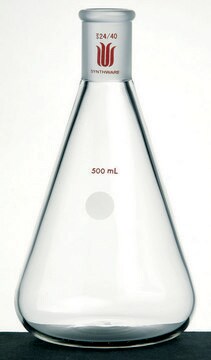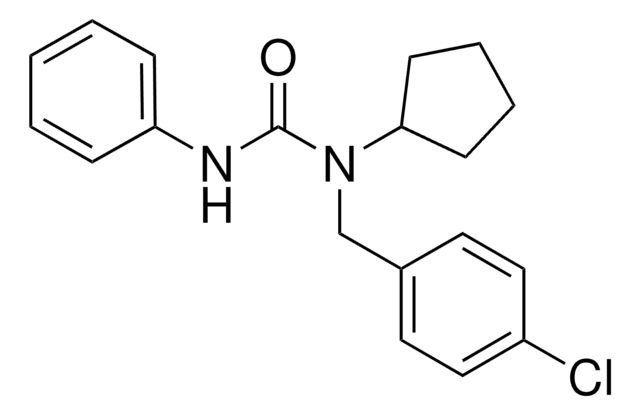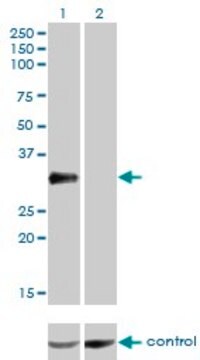추천 제품
생물학적 소스
rabbit
Quality Level
결합
unconjugated
항체 형태
IgG fraction of antiserum
항체 생산 유형
primary antibodies
클론
polyclonal
형태
buffered aqueous solution
종 반응성
human
기술
indirect ELISA: 1:1000
NCBI 수납 번호
UniProt 수납 번호
배송 상태
dry ice
저장 온도
−20°C
타겟 번역 후 변형
unmodified
유전자 정보
human ... PTPRB(5787)
일반 설명
Phosphorylation of receptors by protein kinases is a process that can be reversed by a group of enzymes called protein phosphatases. Coordinated control of kinases and phosphatases provides the cell with the capacity to rapidly switch between phosphorylated and dephosphorylated protein states in dynamic response to environmental stimuli. Activation of critical enzymes by kinase phosphorylation alone is not enough to provide adequate regulation – it is the combination with phosphatase dephosphorylation that effectively creates on/off switches to control cellular events. Errors in control, either through kinases or their counterpart phosphatases, can lead to unchecked cell growth attributable to human cancers and developmental disorders. Potential mechanisms to control dephosphorylation include changes in the expression of protein phosphatases, their subcellular localization, phosphorylation of phosphatase catalytic and regulatory subunits and regulation by endogenous phosphatase inhibitors. Most protein phosphatases are not stringently specific for their substrates. Consequently, changes in phosphatase activity may have a broad impact on dephosphorylation and turnover of phosphoproteins that are substrates for different kinases. This may be an important point of control to connect cellular circuitry of interrelated signaling pathways, and to synchronize physiological responses.
면역원
PTPBETA (1957-1993)
This antibody is generated from rabbits immunized with a KLH conjugated synthetic peptide selected from the C-terminal region of human PTPbeta.
This antibody is generated from rabbits immunized with a KLH conjugated synthetic peptide selected from the C-terminal region of human PTPbeta.
생화학적/생리학적 작용
Protein tyrosine phosphatase, receptor type B (PTPRB), also known as vascular endothelial-protein-tyrosine phosphatase (VE-PTP), might have a role in remodeling of blood vessels and in angiogenesis. It is also important for endothelial cell migration. The protein also controls the phosphorylation state of the angiopoietin receptor, Tie-2. PTPRB may modulate sodium channels by influencing the tyrosine phosphorylation status.
물리적 형태
Purified polyclonal antibody supplied in PBS with 0.09% (W/V) sodium azide.
적합한 제품을 찾을 수 없으신가요?
당사의 제품 선택기 도구.을(를) 시도해 보세요.
Storage Class Code
10 - Combustible liquids
WGK
nwg
Flash Point (°F)
Not applicable
Flash Point (°C)
Not applicable
시험 성적서(COA)
제품의 로트/배치 번호를 입력하여 시험 성적서(COA)을 검색하십시오. 로트 및 배치 번호는 제품 라벨에 있는 ‘로트’ 또는 ‘배치’라는 용어 뒤에서 찾을 수 있습니다.
Picomolar concentrations of free zinc(II) ions regulate receptor protein-tyrosine phosphatase ? activity.
Wilson M
The Journal of Biological Chemistry (2012)
Shear stress-induced redistribution of vascular endothelial-protein-tyrosine phosphatase (VE-PTP) in endothelial cells and its role in cell elongation.
Mantilidewi KI
The Journal of Biological Chemistry (2014)
A sodium channel signaling complex: modulation by associated receptor protein tyrosine phosphatase beta.
Ratcliffe CF
Nature Neuroscience (2000)
자사의 과학자팀은 생명 과학, 재료 과학, 화학 합성, 크로마토그래피, 분석 및 기타 많은 영역을 포함한 모든 과학 분야에 경험이 있습니다..
고객지원팀으로 연락바랍니다.







